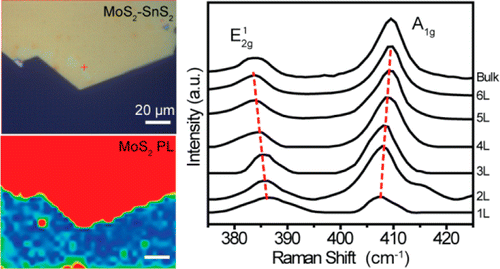Our official English website, www.x-mol.net, welcomes your
feedback! (Note: you will need to create a separate account there.)
Layer-Controlled Chemical Vapor Deposition Growth of MoS2 Vertical Heterostructures via van der Waals Epitaxy
ACS Nano ( IF 15.8 ) Pub Date : 2016-07-07 00:00:00 , DOI: 10.1021/acsnano.6b03112 Leith Samad 1 , Sage M. Bladow 1 , Qi Ding 1 , Junqiao Zhuo 1 , Robert M. Jacobberger 2 , Michael S. Arnold 2 , Song Jin 1
ACS Nano ( IF 15.8 ) Pub Date : 2016-07-07 00:00:00 , DOI: 10.1021/acsnano.6b03112 Leith Samad 1 , Sage M. Bladow 1 , Qi Ding 1 , Junqiao Zhuo 1 , Robert M. Jacobberger 2 , Michael S. Arnold 2 , Song Jin 1
Affiliation

|
The fascinating semiconducting and optical properties of monolayer and few-layer transition metal dichalcogenides, as exemplified by MoS2, have made them promising candidates for optoelectronic applications. Controllable growth of heterostructures based on these layered materials is critical for their successful device applications. Here, we report a direct low temperature chemical vapor deposition (CVD) synthesis of MoS2 monolayer/multilayer vertical heterostructures with layer-controlled growth on a variety of layered materials (SnS2, TaS2, and graphene) via van der Waals epitaxy. Through precise control of the partial pressures of the MoCl5 and elemental sulfur precursors, reaction temperatures, and careful tracking of the ambient humidity, we have successfully and reproducibly grown MoS2 vertical heterostructures from 1 to 6 layers over a large area. The monolayer MoS2 heterostructure was verified using cross-sectional high resolution transmission electron microscopy (HRTEM) while Raman and photoluminescence spectroscopy confirmed the layer-controlled MoS2 growth and heterostructure electronic interactions. Raman, photoluminescence, and energy dispersive X-ray spectroscopy (EDS) mappings verified the uniform coverage of the MoS2 layers. This reaction provides an ideal method for the scalable layer-controlled growth of transition metal dichalcogenide heterostructures via van der Waals epitaxy for a variety of optoelectronic applications.
中文翻译:

通过范德华外延生长进行MoS 2垂直异质结构的层控制化学气相沉积生长
如MoS 2所示,单层和几层过渡金属二卤化物具有令人着迷的半导体和光学性质,使其成为光电子应用的有希望的候选者。基于这些分层材料的异质结构的可控生长对于其成功的器件应用至关重要。这里,我们报告的MoS的直接低温化学气相沉积(CVD)合成2单层/多层垂直异质与各种层状材料(的SnS层控制的生长2,TAS 2和石墨烯)经由范德华外延。通过精确控制MoCl 5的分压以及元素硫的前驱体,反应温度以及对环境湿度的仔细跟踪,我们已经成功且可复制地在大面积上从1层到6层生长了MoS 2垂直异质结构。使用截面高分辨率透射电子显微镜(HRTEM)验证了单层MoS 2异质结构,而拉曼光谱和光致发光光谱法证实了层控MoS 2的生长和异质结构电子相互作用。拉曼光谱,光致发光和能量色散X射线光谱(EDS)映射证明了MoS 2的均匀覆盖层。该反应提供了一种理想的方法,通过范德华外延可扩展地控制过渡金属二硫化氢异质结构的层生长,适用于各种光电应用。
更新日期:2016-07-07
中文翻译:

通过范德华外延生长进行MoS 2垂直异质结构的层控制化学气相沉积生长
如MoS 2所示,单层和几层过渡金属二卤化物具有令人着迷的半导体和光学性质,使其成为光电子应用的有希望的候选者。基于这些分层材料的异质结构的可控生长对于其成功的器件应用至关重要。这里,我们报告的MoS的直接低温化学气相沉积(CVD)合成2单层/多层垂直异质与各种层状材料(的SnS层控制的生长2,TAS 2和石墨烯)经由范德华外延。通过精确控制MoCl 5的分压以及元素硫的前驱体,反应温度以及对环境湿度的仔细跟踪,我们已经成功且可复制地在大面积上从1层到6层生长了MoS 2垂直异质结构。使用截面高分辨率透射电子显微镜(HRTEM)验证了单层MoS 2异质结构,而拉曼光谱和光致发光光谱法证实了层控MoS 2的生长和异质结构电子相互作用。拉曼光谱,光致发光和能量色散X射线光谱(EDS)映射证明了MoS 2的均匀覆盖层。该反应提供了一种理想的方法,通过范德华外延可扩展地控制过渡金属二硫化氢异质结构的层生长,适用于各种光电应用。

































 京公网安备 11010802027423号
京公网安备 11010802027423号